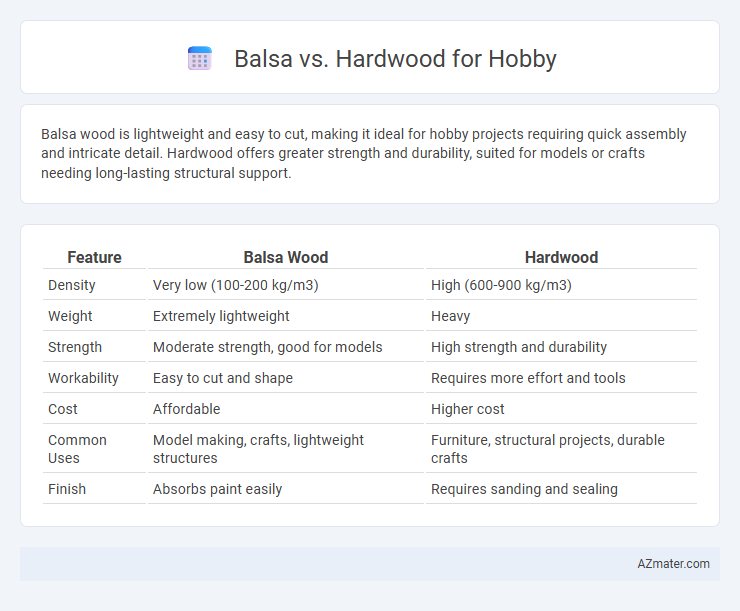Balsa wood is lightweight and easy to cut, making it ideal for hobby projects requiring quick assembly and intricate detail. Hardwood offers greater strength and durability, suited for models or crafts needing long-lasting structural support.
Table of Comparison
| Feature | Balsa Wood | Hardwood |
|---|---|---|
| Density | Very low (100-200 kg/m3) | High (600-900 kg/m3) |
| Weight | Extremely lightweight | Heavy |
| Strength | Moderate strength, good for models | High strength and durability |
| Workability | Easy to cut and shape | Requires more effort and tools |
| Cost | Affordable | Higher cost |
| Common Uses | Model making, crafts, lightweight structures | Furniture, structural projects, durable crafts |
| Finish | Absorbs paint easily | Requires sanding and sealing |
Introduction to Balsa and Hardwood in Hobbies
Balsa wood, known for its lightweight and soft texture, is ideal for hobby projects that require easy cutting and shaping, such as model airplanes and architectural prototypes. Hardwood, including species like oak, maple, and walnut, offers superior strength and durability, making it suitable for detailed woodworking, furniture building, and hobby crafts that demand a sturdy finish. Choosing between balsa and hardwood depends on the specific requirements of the hobby, balancing ease of use with the desired structural integrity.
Material Properties: Balsa vs Hardwood
Balsa wood is significantly lighter and softer than hardwoods, making it ideal for hobby applications requiring easy shaping and minimal weight. Hardwood offers superior strength, density, and durability, which benefits projects needing long-lasting structural integrity. The choice between balsa and hardwood depends on the balance of weight, strength, and ease of workability required for the specific hobby task.
Weight and Density Comparison
Balsa wood is significantly lighter and less dense than hardwood, with a density ranging from 100 to 200 kg/m3 compared to hardwood's 600 to 900 kg/m3, making balsa ideal for hobby projects requiring minimal weight. The low density of balsa allows for easy cutting, shaping, and sanding, which benefits model building and lightweight structures. Hardwood's higher density provides greater strength and durability but adds more weight, making it preferable for sturdy, long-lasting hobby crafts.
Workability and Ease of Shaping
Balsa wood offers exceptional workability due to its lightweight and soft texture, making it ideal for hobbyists who require easy shaping and quick adjustments. Hardwood, while denser and stronger, demands more tools and effort for cutting and carving but provides greater durability for intricate projects. Choosing between balsa and hardwood depends on the balance between ease of manipulation and the desired strength of the finished model.
Strength and Durability Factors
Balsa wood offers lightweight properties but lacks the strength and durability required for demanding hobby projects, often making it susceptible to dents and breakage. Hardwood varieties like oak or maple provide superior strength and long-lasting durability, ideal for hobbyists requiring robust materials that withstand wear and tear. The choice between balsa and hardwood hinges on balancing the project's weight requirements against the need for structural integrity and resilience.
Cost and Availability Analysis
Balsa wood offers a cost-effective option for hobbyists due to its lightweight nature and widespread availability in craft stores and online retailers. Hardwood varieties, while more expensive, provide greater durability and are often sourced from specialized suppliers, leading to higher material costs and less accessibility for casual projects. The choice between balsa and hardwood hinges on balancing budget constraints against the desired strength and finish of the final hobby creation.
Preferred Uses in Model-Building
Balsa wood is preferred in model-building for its lightweight and easy-to-shape properties, making it ideal for aircraft models, architectural mock-ups, and intricate detailing. Hardwood, such as oak or maple, is favored for structural components requiring durability and strength, often used in model ships, furniture replicas, and bases. Hobbyists choose balsa for speed and flexibility, while hardwood offers long-lasting stability and heavier support.
Performance in RC and Aeronautics
Balsa wood offers superior strength-to-weight ratio and excellent shock absorption, making it ideal for RC aircraft and aeronautic hobby projects requiring agility and lightweight performance. Hardwood provides greater durability and rigidity, which benefits larger models or components subjected to higher stress and impact. Selecting between balsa and hardwood depends on balancing lightweight flight efficiency with structural resilience in RC and aeronautic applications.
Finishing and Painting Qualities
Balsa wood offers superior absorption properties, allowing paint and finishes to adhere smoothly and dry quickly, making it ideal for hobby projects requiring fine detail and vibrant colors. Hardwood presents a denser surface that may require additional sanding and priming for even paint application but provides a durable, long-lasting finish suitable for detailed carvings and structural components. Both materials offer distinct finishing qualities: balsa excels in lightweight, easily painted models, while hardwood ensures a robust, polished appearance in hobby crafts.
Choosing the Right Wood for Your Project
Balsa wood offers unparalleled lightweight characteristics, making it ideal for hobbyists focused on model airplanes and crafts requiring easy shaping and rapid assembly. Hardwood provides superior durability and strength, suited for projects needing structural integrity and a polished finish, such as furniture or intricate woodcarving. Selecting the right wood depends on project requirements: choose balsa for ease of use and weight constraints, and hardwood for lasting strength and aesthetic appeal.

Infographic: Balsa vs Hardwood for Hobby
 azmater.com
azmater.com